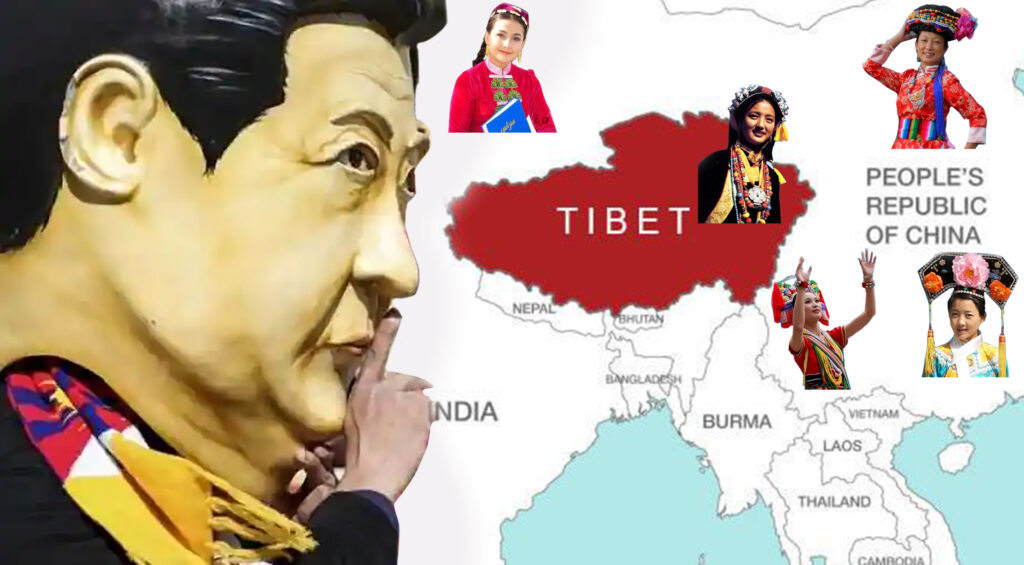CNI Article News
26 June 2024
China has intensified efforts to promote Han culture and assimilation policies in Tibet even as former US Congress Speaker Nancy Pelosi recently met Tibetan spiritual leader the Dalai Lama as a member of a US Congressional delegation.
Irritated by the recent passage of the Resolve Tibet Act by the U.S. Senate and the legacy of the Dalai Lama, particularly the issue of his reincarnation, the Chinese government has expressed its intent to have full control, including the reincarnation process in Tibet.
Available reports indicate that the Chinese government has been making efforts to assimilate Tibetan culture into the dominant Han culture.
Experts on Tibetan affairs said that China’s arrogant approach to education in Tibet has raised significant concerns regarding the forced assimilation of Tibetan children.
Approximately one million Tibetan children have reportedly been separated from their families and placed into government-run boarding schools.
Former member of the Tibetan parliament in exile, KhedroobThondup, said that the educational content in these schools is centered around the majority Han culture, with Mandarin Chinese (Putonghua) as the medium of instruction.

This system is seen as a large-scale program intended to assimilate Tibetans into Han culture. The focus on Mandarin Chinese and Han cultural norms has resulted in Tibetan children losing proficiency in their native language and, consequently, the ability to communicate effectively with their elders, contributing to the erosion of their Tibetan identity.
The increase in boarding students is partly due to the closure of rural schools in Tibetan areas, replaced by township or county-level schools that primarily use Mandarin Chinese for teaching and communication, often requiring children to board. This forced assimilation is contrary to international human rights standards concerning education, linguistic and cultural rights, and freedom of religion or belief.
Religious repression is another form of China's attempt to assimilate Tibetan culture. The Chinese constitution states citizens ‘enjoy freedom of religious belief’, but limits protections to ‘normal religious activities’ without defining ‘normal’. The Chinese Communist Party (CCP) promotes ‘Sinicization’ policies that aim to interpret religious ideas in accordance with CCP ideology and emphasize loyalty to the CCP and the state.
The demolition of the Fuyan Temple, a 1,000-year-old Tibetan Buddhist temple in Jinzhong City, Shanxi Province, is an example of how Chinese authorities have destroyed Tibetan religious sites outside the Tibet Autonomous Region (TAR).
The arrests of writers, singers, and artists for promoting the Tibetan language and culture are also reported.

Supporters of the Dalai Lama and other religious leaders could be arrested under the government’s anti-organized-crime program. The Chinese government has conducted a campaign of “reeducation” or “vocational training” in military-style camps for political indoctrination and to transform traditional farmers and herders into laborers in other industries.
Tibetans are not allowed to practice their own religion and maintain their cultural identity.
Various human rights organizations and independent experts have expressed concern regarding the preservation of Tibetan culture and identity.
China's efforts to assimilate Tibetans into Han culture are part of a broader campaign to create a single national identity centered on the Han majority and loyalty to the Communist Party.
The CCP considers cultural assimilation essential for national unity and stability.
Historically, China has sought to create a unified national identity.
The promotion of Han culture, which is the majority culture in China, is seen as a way to strengthen national unity and cohesion.
This approach is rooted in the imperial legacy, where Tibet was considered part of Chinese empires at various points in history.
The Xi government views the assimilation of Tibet as a continuation of this legacy, aiming to reinforce the perception of a cohesive and indivisible China.
Experts said that the aim of the Chinese government is to consolidate its control over Tibet through Han culture and encouraging assimilation.
This strategy is seen as a way to mitigate separatist sentiments and potential challenges to Beijing's authority.
The CCP seeks to bolster its legitimacy by demonstrating its ability to unify and integrate diverse regions and cultures within China.
This is crucial for maintaining domestic support and stability.

Lastly, Tibet's strategic significance cannot be overstated. Sharing borders with several countries, including India, Nepal, and Bhutan, Tibet's stability is vital for China's geopolitical strategy.
China wants to ensure that Tibet is firmly under Beijing's control because it is essential for regional security and influence.
Additionally, integrating Tibet economically and culturally can facilitate smoother governance and align the region more closely with the central government's policies and initiatives.
These assimilation policies have faced significant criticism from international human rights organizations as they infringe on the cultural and religious freedoms of the Tibetan people.
Experts on Tibetan affairs regret that the focus on Mandarin Chinese and Han cultural norms in education has led to Tibetan children losing proficiency in their native language, contributing to the erosion of their cultural identity.
The closure of rural schools and the rise of government-run boarding schools using Mandarin as the primary language of instruction have further marginalized Tibetan cultural practices and traditions.
China's promotion of Han culture and assimilation policies in Tibet aims to create a unified national identity and strengthen central control by Beijing, but they have also led to significant resistance and international criticism.
The forced assimilation of Tibetan children through the education system, religious repression, and cultural suppression highlight the severe impact on Tibetan society.
The balance between these efforts and the response from the local populations will continue to shape the future of China's relationship with Tibet.




